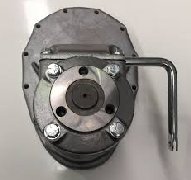Dog Clutch Maintinence & Issues
Details:
Issues you could have with the dog clutch drive system
Most people may experience their dog clutch is not working 100%
Here Precision Marine will give advice to rectify the issues.
HARD SHIFTING
Engine should idle between 500 to 600rpm for best results.
High idle rpm causes it harder to engage and disengage.
Over time the clutch shift lever/handle may wear and need replacement.
Different types of levers available and some are easier to use than others.
Replace if required.
The ball joint fittings that are usually used on the shift rod will wear over time and allows free-play on the shaft. They require replacement as this will limit clutch fork movement and can falloff.
Careful inspections should be made regarding fork wear which is normal after years of use.
Most forks are made of bronze while others are alloy made forks with cap screws threaded in to act as the pressure point.
Many different forks are available to suit each different dog clutch.
If the bronze forks show 50% wear or more on the friction section it is advisable to replace as worn forks create unwanted movement and may brake.
Occasionally the alloy forks may also fail.
Some forks have threaded cap screws through the s/s fork shaft and are usually sold as a complete unit.
Sometimes the fixing screws into the stainless shaft may come loose or break creating excess movement and often requiring replacement.
Clutch fork not adjusted correctly.
Remove top where possible and visually note that when lever in engaged that the fork has moved the slider gear forward to just engage the crank gear when it is lined up to allow it do so.
When dogs are fully engaged there should be no pressure against the fork.
Some brands of dog clutches have the fork and rod mounted in the top housing and is removed as a unit. Adjustment can be done by disconnecting the shift rod and aligning the dogs so they will engage, then move the fork forward until light contact is felt, then refit the ball joint to the shift rod while the handle is in the engaged position.
The fork is there only to shift it into gear and not to hold it in gear as any pressure will wear to fork prematurely.
The undercut machining on the dogs is the only aspect that holds the dog clutch in gear.
Usually the first notice of a worn clutch dog Is when backing off the boat from speed the clutch will drop out into neutral.
In most cases in boats that has not had a crank dog replaced in the last 25yrs or so you will find the most worn part will be the crank dog owing to the inability of case hardening that dog. Most cases removal fo the crank dog is very difficult and time consuming.
The replacement of the the crankshaft dog will be two piece with the dog section more easily replaced if required.
V8 Holdens sometimes sheer the woodruff key locating the crank dog and as a result may damage the crankshaft resulting in removal and machining to suit a available undersize crank dog.
With crank dog replacement there is options to the type of crank dog that can be fitted.
Inspection of the slider gear is required however often still serviceable.
The slider dog replacement is available in two spline types and not interchangeable.
Having said all of the above the popular Dog clutch is a very trouble free drive system if used and maintained correctly.
All off the above is compiled from knowledge gained by PRECISION MARINE over the years.
more information about this product


 Click Image to Enlarge
Click Image to Enlarge
View Video Galleries
Helpful information for the boaters; tips and entertainment collection.
View Photo Galleries
A collection of photo galleries related to
ski-racing, fishing and water sports.
Share with